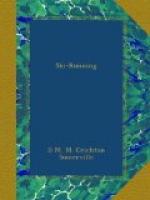ACCIDENTS
Some people will think that I lay too much stress on the dangers of Ski-ing. Considering the thousands of people who ski every Winter and the extraordinarily small number of accidents, I admit that I have exaggerated the dangers. But I do so quite deliberately because it is only by realizing risks that they can be avoided, and my experience proves to me that the average town-bred man and woman, boy and girl have very little appreciation of life lived up against Nature. They set out so lightheartedly and often so fool-hardily on an expedition, without telling anyone where they propose to go, or when they expect to be home, and without having provided themselves with the extra equipment which may prove to be very necessary before the day is finished.
While writing this book I have constantly had in mind Ski-ing centres above 5,000 feet, whence tours are made among the glaciers and at high levels where the cold may be a danger during the months of January and February. Much of what I have said of the necessity of carrying spare clothing in good quantity does not apply so much to places below 5,000 feet unless high tours are undertaken. But wherever people ski there is a possibility of accidents due to falls, and though these are seldom serious, they need attention.
When someone is really lamed by knee or ankle, Ski-ing becomes very difficult, except to the expert, who can ski mainly on one foot, and walking through the deep snow, sinking at every step, is an agony, so that some form of stretcher becomes necessary.
Two or, better still, four Skis tied together, side by side, form an excellent sledge, which will travel straight downhill every easily. It practically refuses to traverse a slope so that the case has to be slipped straight down to the bottom of the slope and along the valley or level below.
Skis usually have holes through the flat part of the tip in front. A piece of strong wire should be threaded through these, care being taken that the Skis lie parallel their whole length and that the tips are not drawn together too much. A stick must be tied to the wire and the Ski tips to keep them in position and to take the pull when the sledge is drawn along. If there are trees about, a branch can be cut to serve this purpose. If not, a Ski stick must be cut in half and used. It should not project beyond the Skis on either side, or it will catch in the snow.
The other half of the Ski stick or another branch must be tied across the Skis, by the toe irons, to keep the Skis parallel there also, and to give solidity to the sledge. People sometimes tie a strap or string round the Skis, including their running surfaces, forgetting that this will soon cut through with the friction of the snow.
To finish the sledge, put some fir branches on it, the bushy part of which will make it more comfortable to lie on. The thick wood of the branch part should point towards the front of the Skis and be fixed there. If branches are not available, Rucksacks can be used for the injured person to lie on. He will probably be more comfortable going downhill if he can be laid head-first downwards on the sledge.




